Australian Hospitals: Funding Models, NEP and Health Incentives
VerifiedAdded on 2023/04/25
|7
|1683
|208
Report
AI Summary
This report identifies the funding model used by public hospitals in Australia, focusing on the maintenance of safety and quality standards to secure funding. It discusses the National Efficient Price (NEP) and its potential as an incentive to improve the health status of specific segments within the Australian population, particularly the aboriginal and indigenous communities. The report highlights how NEP can distribute funds and incentives to uplift deprived sections, address health inequalities, and support hospitals that prioritize safety and quality measures. It references studies that demonstrate the poor health conditions among aboriginals and the need for targeted incentives to combat diseases like bronchiectasis. The analysis concludes that NEP should expand its funding procedures to hospitals implementing quality and safety measures for the indigenous population, ultimately improving their health outcomes.
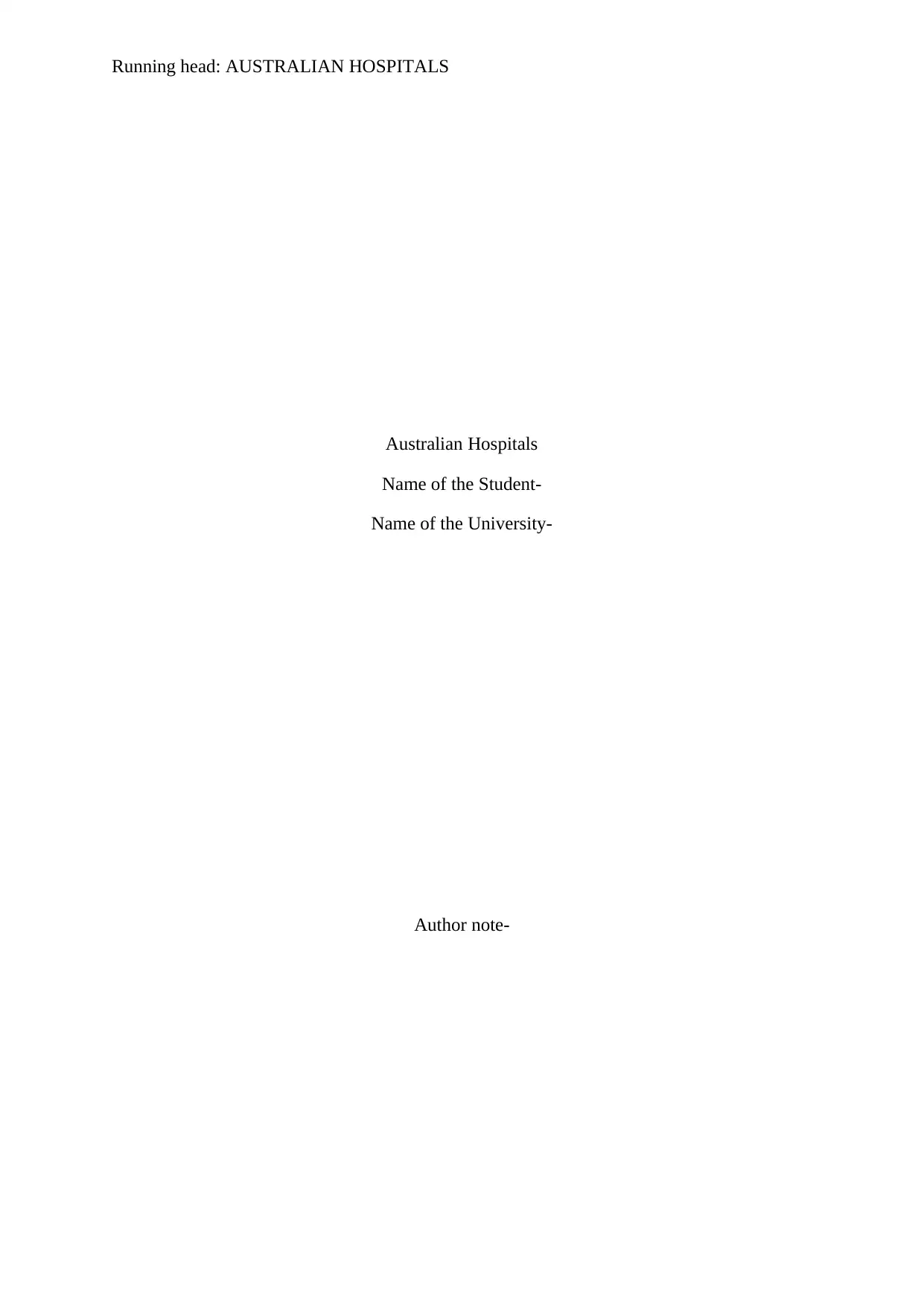
Running head: AUSTRALIAN HOSPITALS
Australian Hospitals
Name of the Student-
Name of the University-
Author note-
Australian Hospitals
Name of the Student-
Name of the University-
Author note-
Paraphrase This Document
Need a fresh take? Get an instant paraphrase of this document with our AI Paraphraser
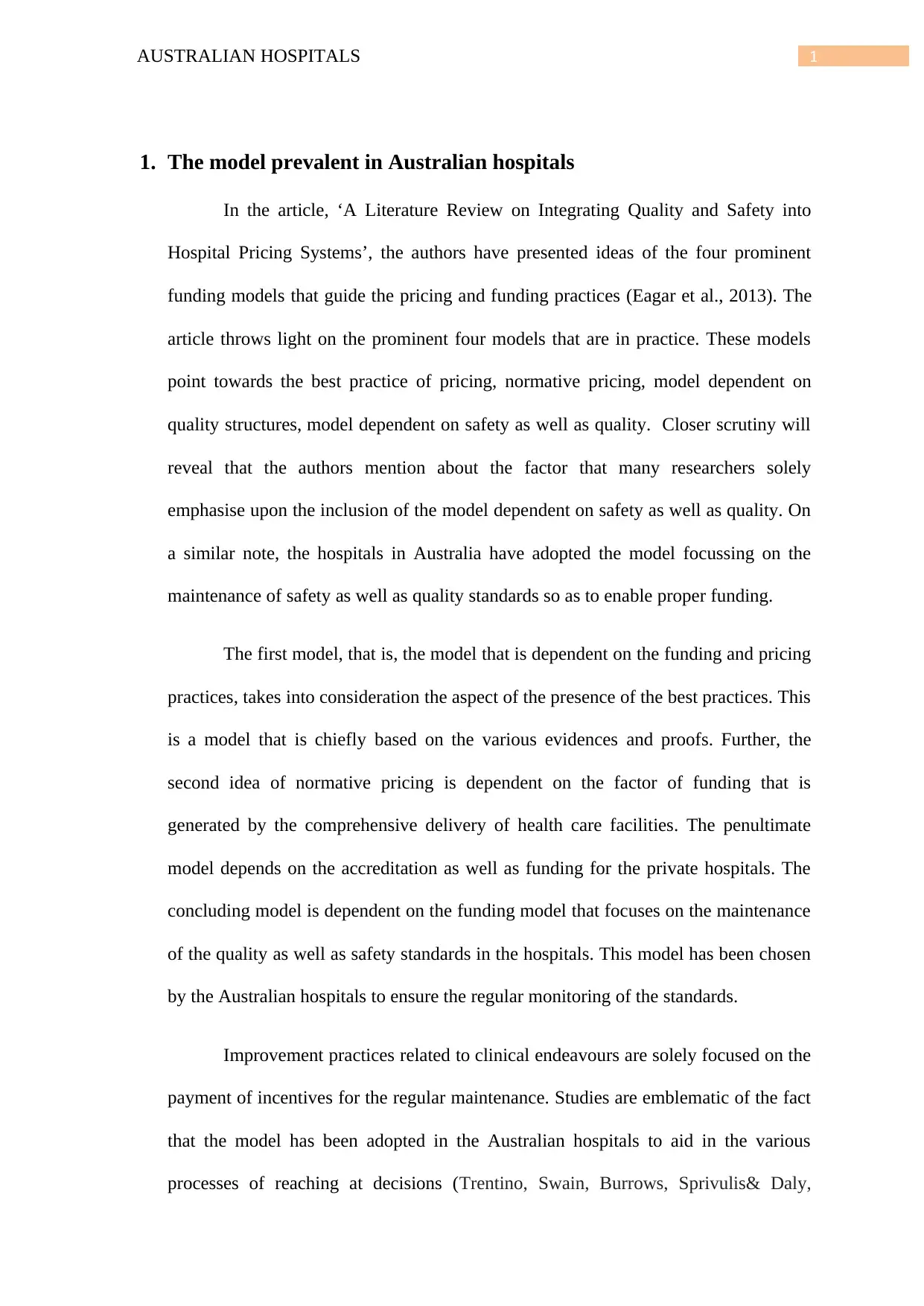
1AUSTRALIAN HOSPITALS
1. The model prevalent in Australian hospitals
In the article, ‘A Literature Review on Integrating Quality and Safety into
Hospital Pricing Systems’, the authors have presented ideas of the four prominent
funding models that guide the pricing and funding practices (Eagar et al., 2013). The
article throws light on the prominent four models that are in practice. These models
point towards the best practice of pricing, normative pricing, model dependent on
quality structures, model dependent on safety as well as quality. Closer scrutiny will
reveal that the authors mention about the factor that many researchers solely
emphasise upon the inclusion of the model dependent on safety as well as quality. On
a similar note, the hospitals in Australia have adopted the model focussing on the
maintenance of safety as well as quality standards so as to enable proper funding.
The first model, that is, the model that is dependent on the funding and pricing
practices, takes into consideration the aspect of the presence of the best practices. This
is a model that is chiefly based on the various evidences and proofs. Further, the
second idea of normative pricing is dependent on the factor of funding that is
generated by the comprehensive delivery of health care facilities. The penultimate
model depends on the accreditation as well as funding for the private hospitals. The
concluding model is dependent on the funding model that focuses on the maintenance
of the quality as well as safety standards in the hospitals. This model has been chosen
by the Australian hospitals to ensure the regular monitoring of the standards.
Improvement practices related to clinical endeavours are solely focused on the
payment of incentives for the regular maintenance. Studies are emblematic of the fact
that the model has been adopted in the Australian hospitals to aid in the various
processes of reaching at decisions (Trentino, Swain, Burrows, Sprivulis& Daly,
1. The model prevalent in Australian hospitals
In the article, ‘A Literature Review on Integrating Quality and Safety into
Hospital Pricing Systems’, the authors have presented ideas of the four prominent
funding models that guide the pricing and funding practices (Eagar et al., 2013). The
article throws light on the prominent four models that are in practice. These models
point towards the best practice of pricing, normative pricing, model dependent on
quality structures, model dependent on safety as well as quality. Closer scrutiny will
reveal that the authors mention about the factor that many researchers solely
emphasise upon the inclusion of the model dependent on safety as well as quality. On
a similar note, the hospitals in Australia have adopted the model focussing on the
maintenance of safety as well as quality standards so as to enable proper funding.
The first model, that is, the model that is dependent on the funding and pricing
practices, takes into consideration the aspect of the presence of the best practices. This
is a model that is chiefly based on the various evidences and proofs. Further, the
second idea of normative pricing is dependent on the factor of funding that is
generated by the comprehensive delivery of health care facilities. The penultimate
model depends on the accreditation as well as funding for the private hospitals. The
concluding model is dependent on the funding model that focuses on the maintenance
of the quality as well as safety standards in the hospitals. This model has been chosen
by the Australian hospitals to ensure the regular monitoring of the standards.
Improvement practices related to clinical endeavours are solely focused on the
payment of incentives for the regular maintenance. Studies are emblematic of the fact
that the model has been adopted in the Australian hospitals to aid in the various
processes of reaching at decisions (Trentino, Swain, Burrows, Sprivulis& Daly,
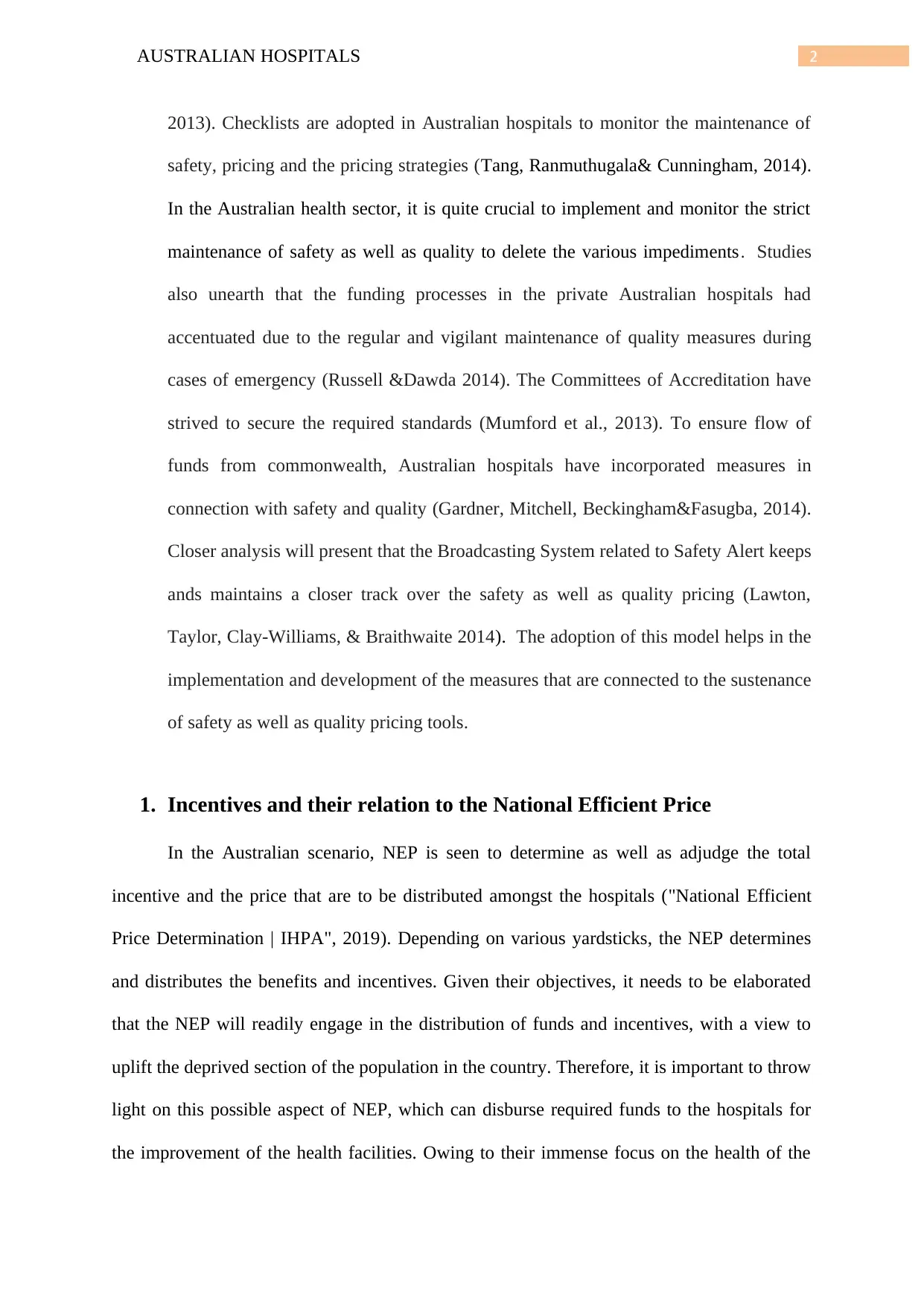
2AUSTRALIAN HOSPITALS
2013). Checklists are adopted in Australian hospitals to monitor the maintenance of
safety, pricing and the pricing strategies (Tang, Ranmuthugala& Cunningham, 2014).
In the Australian health sector, it is quite crucial to implement and monitor the strict
maintenance of safety as well as quality to delete the various impediments. Studies
also unearth that the funding processes in the private Australian hospitals had
accentuated due to the regular and vigilant maintenance of quality measures during
cases of emergency (Russell &Dawda 2014). The Committees of Accreditation have
strived to secure the required standards (Mumford et al., 2013). To ensure flow of
funds from commonwealth, Australian hospitals have incorporated measures in
connection with safety and quality (Gardner, Mitchell, Beckingham&Fasugba, 2014).
Closer analysis will present that the Broadcasting System related to Safety Alert keeps
ands maintains a closer track over the safety as well as quality pricing (Lawton,
Taylor, Clay-Williams, & Braithwaite 2014). The adoption of this model helps in the
implementation and development of the measures that are connected to the sustenance
of safety as well as quality pricing tools.
1. Incentives and their relation to the National Efficient Price
In the Australian scenario, NEP is seen to determine as well as adjudge the total
incentive and the price that are to be distributed amongst the hospitals ("National Efficient
Price Determination | IHPA", 2019). Depending on various yardsticks, the NEP determines
and distributes the benefits and incentives. Given their objectives, it needs to be elaborated
that the NEP will readily engage in the distribution of funds and incentives, with a view to
uplift the deprived section of the population in the country. Therefore, it is important to throw
light on this possible aspect of NEP, which can disburse required funds to the hospitals for
the improvement of the health facilities. Owing to their immense focus on the health of the
2013). Checklists are adopted in Australian hospitals to monitor the maintenance of
safety, pricing and the pricing strategies (Tang, Ranmuthugala& Cunningham, 2014).
In the Australian health sector, it is quite crucial to implement and monitor the strict
maintenance of safety as well as quality to delete the various impediments. Studies
also unearth that the funding processes in the private Australian hospitals had
accentuated due to the regular and vigilant maintenance of quality measures during
cases of emergency (Russell &Dawda 2014). The Committees of Accreditation have
strived to secure the required standards (Mumford et al., 2013). To ensure flow of
funds from commonwealth, Australian hospitals have incorporated measures in
connection with safety and quality (Gardner, Mitchell, Beckingham&Fasugba, 2014).
Closer analysis will present that the Broadcasting System related to Safety Alert keeps
ands maintains a closer track over the safety as well as quality pricing (Lawton,
Taylor, Clay-Williams, & Braithwaite 2014). The adoption of this model helps in the
implementation and development of the measures that are connected to the sustenance
of safety as well as quality pricing tools.
1. Incentives and their relation to the National Efficient Price
In the Australian scenario, NEP is seen to determine as well as adjudge the total
incentive and the price that are to be distributed amongst the hospitals ("National Efficient
Price Determination | IHPA", 2019). Depending on various yardsticks, the NEP determines
and distributes the benefits and incentives. Given their objectives, it needs to be elaborated
that the NEP will readily engage in the distribution of funds and incentives, with a view to
uplift the deprived section of the population in the country. Therefore, it is important to throw
light on this possible aspect of NEP, which can disburse required funds to the hospitals for
the improvement of the health facilities. Owing to their immense focus on the health of the
⊘ This is a preview!⊘
Do you want full access?
Subscribe today to unlock all pages.

Trusted by 1+ million students worldwide
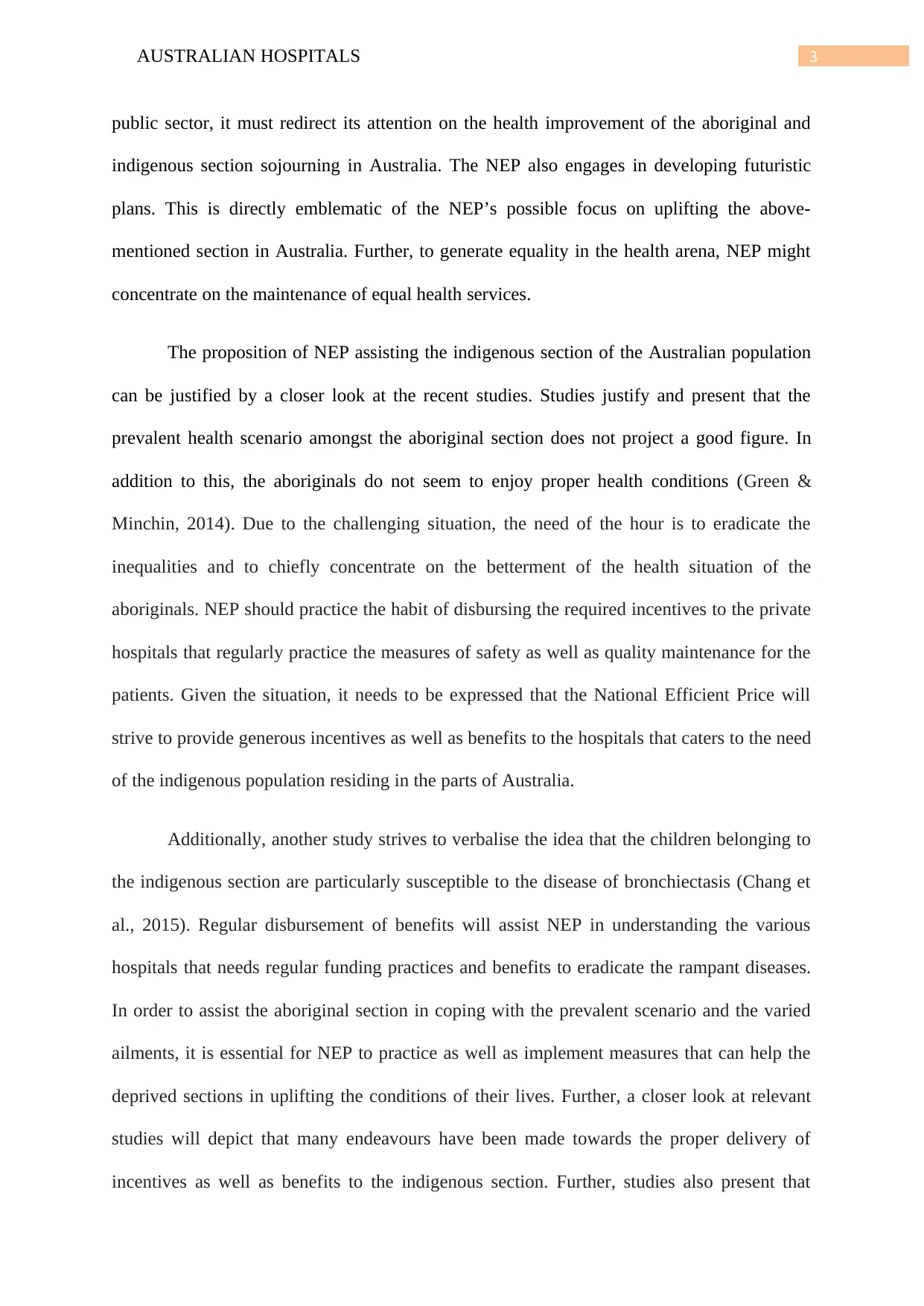
3AUSTRALIAN HOSPITALS
public sector, it must redirect its attention on the health improvement of the aboriginal and
indigenous section sojourning in Australia. The NEP also engages in developing futuristic
plans. This is directly emblematic of the NEP’s possible focus on uplifting the above-
mentioned section in Australia. Further, to generate equality in the health arena, NEP might
concentrate on the maintenance of equal health services.
The proposition of NEP assisting the indigenous section of the Australian population
can be justified by a closer look at the recent studies. Studies justify and present that the
prevalent health scenario amongst the aboriginal section does not project a good figure. In
addition to this, the aboriginals do not seem to enjoy proper health conditions (Green &
Minchin, 2014). Due to the challenging situation, the need of the hour is to eradicate the
inequalities and to chiefly concentrate on the betterment of the health situation of the
aboriginals. NEP should practice the habit of disbursing the required incentives to the private
hospitals that regularly practice the measures of safety as well as quality maintenance for the
patients. Given the situation, it needs to be expressed that the National Efficient Price will
strive to provide generous incentives as well as benefits to the hospitals that caters to the need
of the indigenous population residing in the parts of Australia.
Additionally, another study strives to verbalise the idea that the children belonging to
the indigenous section are particularly susceptible to the disease of bronchiectasis (Chang et
al., 2015). Regular disbursement of benefits will assist NEP in understanding the various
hospitals that needs regular funding practices and benefits to eradicate the rampant diseases.
In order to assist the aboriginal section in coping with the prevalent scenario and the varied
ailments, it is essential for NEP to practice as well as implement measures that can help the
deprived sections in uplifting the conditions of their lives. Further, a closer look at relevant
studies will depict that many endeavours have been made towards the proper delivery of
incentives as well as benefits to the indigenous section. Further, studies also present that
public sector, it must redirect its attention on the health improvement of the aboriginal and
indigenous section sojourning in Australia. The NEP also engages in developing futuristic
plans. This is directly emblematic of the NEP’s possible focus on uplifting the above-
mentioned section in Australia. Further, to generate equality in the health arena, NEP might
concentrate on the maintenance of equal health services.
The proposition of NEP assisting the indigenous section of the Australian population
can be justified by a closer look at the recent studies. Studies justify and present that the
prevalent health scenario amongst the aboriginal section does not project a good figure. In
addition to this, the aboriginals do not seem to enjoy proper health conditions (Green &
Minchin, 2014). Due to the challenging situation, the need of the hour is to eradicate the
inequalities and to chiefly concentrate on the betterment of the health situation of the
aboriginals. NEP should practice the habit of disbursing the required incentives to the private
hospitals that regularly practice the measures of safety as well as quality maintenance for the
patients. Given the situation, it needs to be expressed that the National Efficient Price will
strive to provide generous incentives as well as benefits to the hospitals that caters to the need
of the indigenous population residing in the parts of Australia.
Additionally, another study strives to verbalise the idea that the children belonging to
the indigenous section are particularly susceptible to the disease of bronchiectasis (Chang et
al., 2015). Regular disbursement of benefits will assist NEP in understanding the various
hospitals that needs regular funding practices and benefits to eradicate the rampant diseases.
In order to assist the aboriginal section in coping with the prevalent scenario and the varied
ailments, it is essential for NEP to practice as well as implement measures that can help the
deprived sections in uplifting the conditions of their lives. Further, a closer look at relevant
studies will depict that many endeavours have been made towards the proper delivery of
incentives as well as benefits to the indigenous section. Further, studies also present that
Paraphrase This Document
Need a fresh take? Get an instant paraphrase of this document with our AI Paraphraser
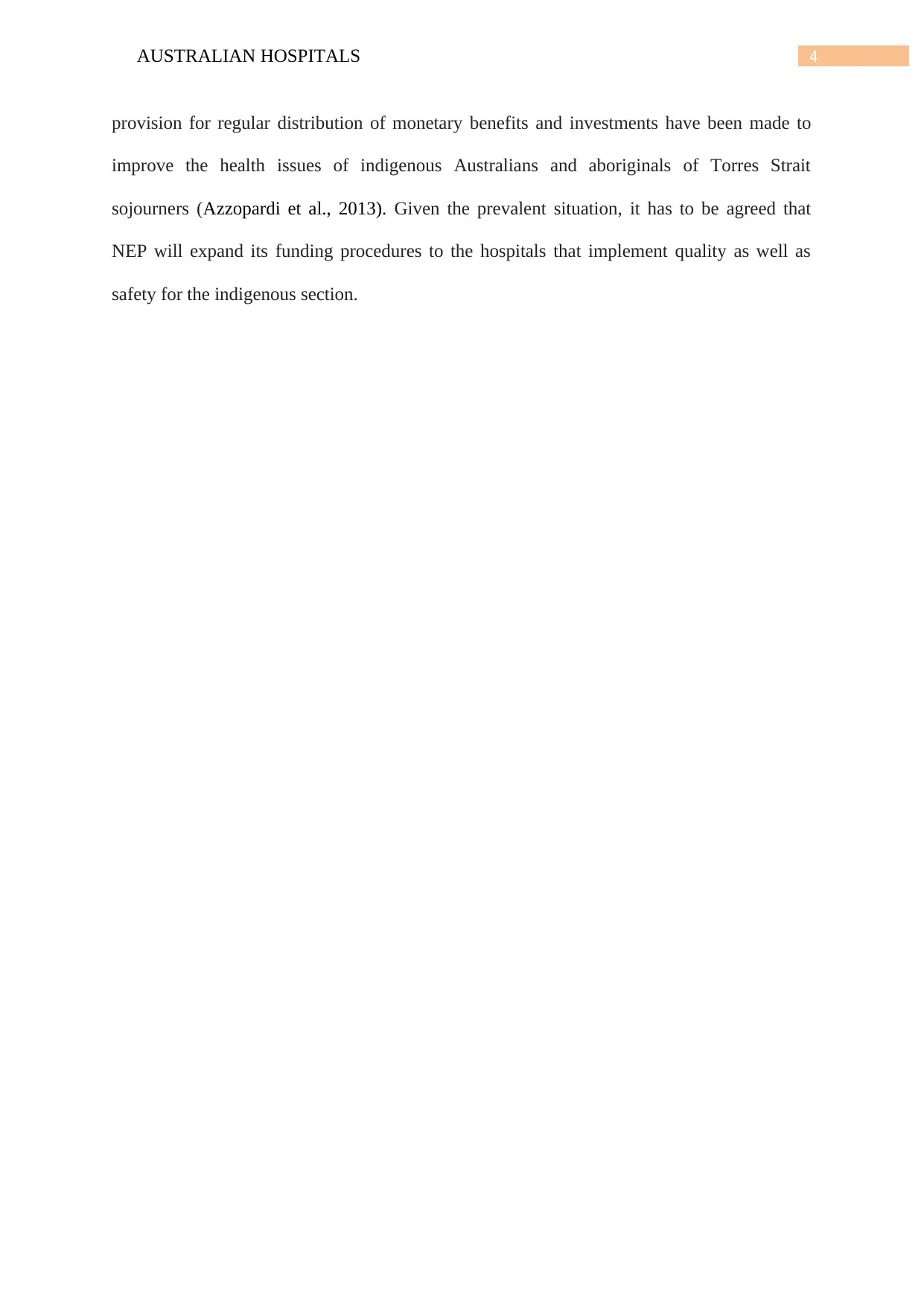
4AUSTRALIAN HOSPITALS
provision for regular distribution of monetary benefits and investments have been made to
improve the health issues of indigenous Australians and aboriginals of Torres Strait
sojourners (Azzopardi et al., 2013). Given the prevalent situation, it has to be agreed that
NEP will expand its funding procedures to the hospitals that implement quality as well as
safety for the indigenous section.
provision for regular distribution of monetary benefits and investments have been made to
improve the health issues of indigenous Australians and aboriginals of Torres Strait
sojourners (Azzopardi et al., 2013). Given the prevalent situation, it has to be agreed that
NEP will expand its funding procedures to the hospitals that implement quality as well as
safety for the indigenous section.
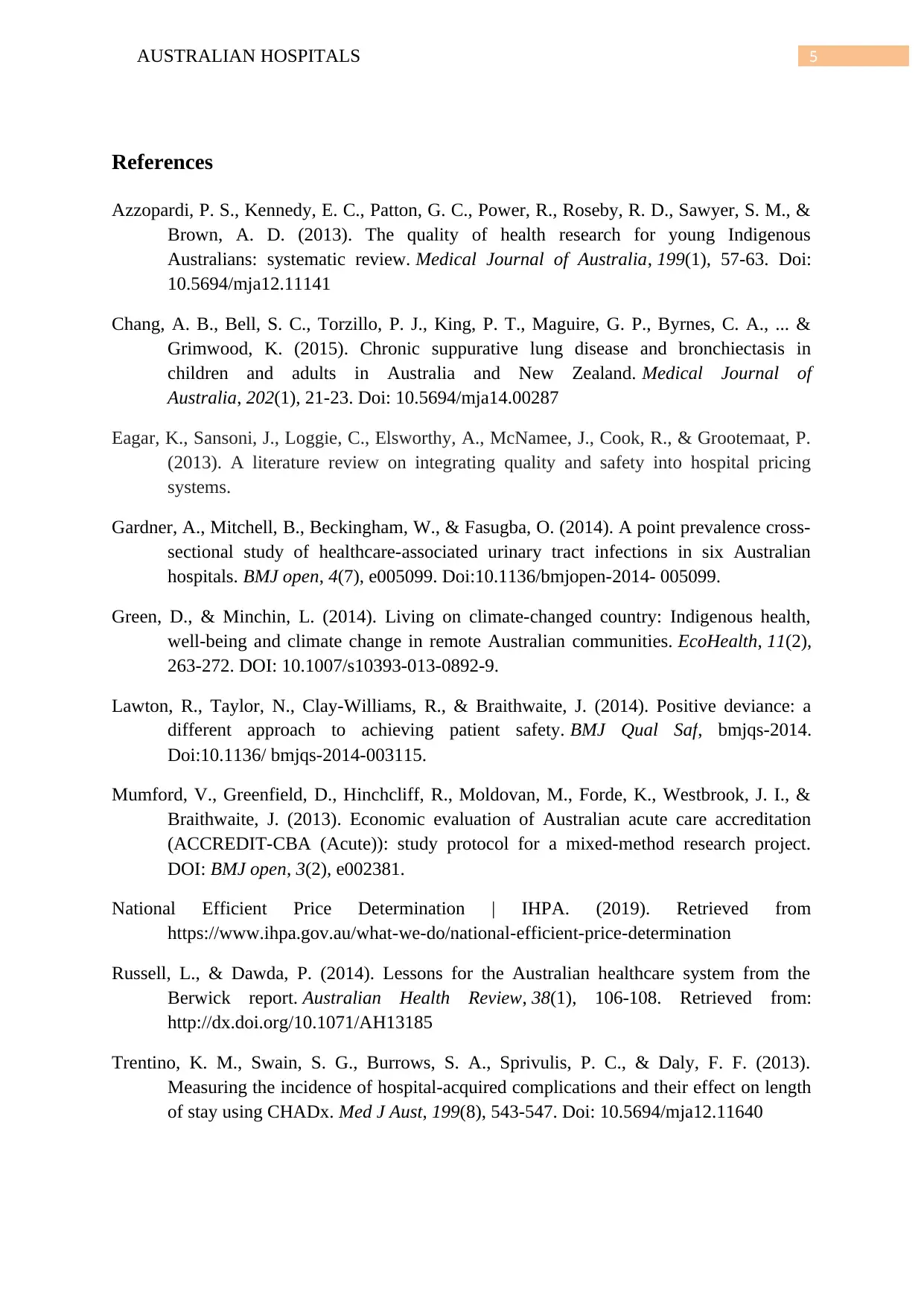
5AUSTRALIAN HOSPITALS
References
Azzopardi, P. S., Kennedy, E. C., Patton, G. C., Power, R., Roseby, R. D., Sawyer, S. M., &
Brown, A. D. (2013). The quality of health research for young Indigenous
Australians: systematic review. Medical Journal of Australia, 199(1), 57-63. Doi:
10.5694/mja12.11141
Chang, A. B., Bell, S. C., Torzillo, P. J., King, P. T., Maguire, G. P., Byrnes, C. A., ... &
Grimwood, K. (2015). Chronic suppurative lung disease and bronchiectasis in
children and adults in Australia and New Zealand. Medical Journal of
Australia, 202(1), 21-23. Doi: 10.5694/mja14.00287
Eagar, K., Sansoni, J., Loggie, C., Elsworthy, A., McNamee, J., Cook, R., & Grootemaat, P.
(2013). A literature review on integrating quality and safety into hospital pricing
systems.
Gardner, A., Mitchell, B., Beckingham, W., & Fasugba, O. (2014). A point prevalence cross-
sectional study of healthcare-associated urinary tract infections in six Australian
hospitals. BMJ open, 4(7), e005099. Doi:10.1136/bmjopen-2014- 005099.
Green, D., & Minchin, L. (2014). Living on climate-changed country: Indigenous health,
well-being and climate change in remote Australian communities. EcoHealth, 11(2),
263-272. DOI: 10.1007/s10393-013-0892-9.
Lawton, R., Taylor, N., Clay-Williams, R., & Braithwaite, J. (2014). Positive deviance: a
different approach to achieving patient safety. BMJ Qual Saf, bmjqs-2014.
Doi:10.1136/ bmjqs-2014-003115.
Mumford, V., Greenfield, D., Hinchcliff, R., Moldovan, M., Forde, K., Westbrook, J. I., &
Braithwaite, J. (2013). Economic evaluation of Australian acute care accreditation
(ACCREDIT-CBA (Acute)): study protocol for a mixed-method research project.
DOI: BMJ open, 3(2), e002381.
National Efficient Price Determination | IHPA. (2019). Retrieved from
https://www.ihpa.gov.au/what-we-do/national-efficient-price-determination
Russell, L., & Dawda, P. (2014). Lessons for the Australian healthcare system from the
Berwick report. Australian Health Review, 38(1), 106-108. Retrieved from:
http://dx.doi.org/10.1071/AH13185
Trentino, K. M., Swain, S. G., Burrows, S. A., Sprivulis, P. C., & Daly, F. F. (2013).
Measuring the incidence of hospital-acquired complications and their effect on length
of stay using CHADx. Med J Aust, 199(8), 543-547. Doi: 10.5694/mja12.11640
References
Azzopardi, P. S., Kennedy, E. C., Patton, G. C., Power, R., Roseby, R. D., Sawyer, S. M., &
Brown, A. D. (2013). The quality of health research for young Indigenous
Australians: systematic review. Medical Journal of Australia, 199(1), 57-63. Doi:
10.5694/mja12.11141
Chang, A. B., Bell, S. C., Torzillo, P. J., King, P. T., Maguire, G. P., Byrnes, C. A., ... &
Grimwood, K. (2015). Chronic suppurative lung disease and bronchiectasis in
children and adults in Australia and New Zealand. Medical Journal of
Australia, 202(1), 21-23. Doi: 10.5694/mja14.00287
Eagar, K., Sansoni, J., Loggie, C., Elsworthy, A., McNamee, J., Cook, R., & Grootemaat, P.
(2013). A literature review on integrating quality and safety into hospital pricing
systems.
Gardner, A., Mitchell, B., Beckingham, W., & Fasugba, O. (2014). A point prevalence cross-
sectional study of healthcare-associated urinary tract infections in six Australian
hospitals. BMJ open, 4(7), e005099. Doi:10.1136/bmjopen-2014- 005099.
Green, D., & Minchin, L. (2014). Living on climate-changed country: Indigenous health,
well-being and climate change in remote Australian communities. EcoHealth, 11(2),
263-272. DOI: 10.1007/s10393-013-0892-9.
Lawton, R., Taylor, N., Clay-Williams, R., & Braithwaite, J. (2014). Positive deviance: a
different approach to achieving patient safety. BMJ Qual Saf, bmjqs-2014.
Doi:10.1136/ bmjqs-2014-003115.
Mumford, V., Greenfield, D., Hinchcliff, R., Moldovan, M., Forde, K., Westbrook, J. I., &
Braithwaite, J. (2013). Economic evaluation of Australian acute care accreditation
(ACCREDIT-CBA (Acute)): study protocol for a mixed-method research project.
DOI: BMJ open, 3(2), e002381.
National Efficient Price Determination | IHPA. (2019). Retrieved from
https://www.ihpa.gov.au/what-we-do/national-efficient-price-determination
Russell, L., & Dawda, P. (2014). Lessons for the Australian healthcare system from the
Berwick report. Australian Health Review, 38(1), 106-108. Retrieved from:
http://dx.doi.org/10.1071/AH13185
Trentino, K. M., Swain, S. G., Burrows, S. A., Sprivulis, P. C., & Daly, F. F. (2013).
Measuring the incidence of hospital-acquired complications and their effect on length
of stay using CHADx. Med J Aust, 199(8), 543-547. Doi: 10.5694/mja12.11640
⊘ This is a preview!⊘
Do you want full access?
Subscribe today to unlock all pages.

Trusted by 1+ million students worldwide
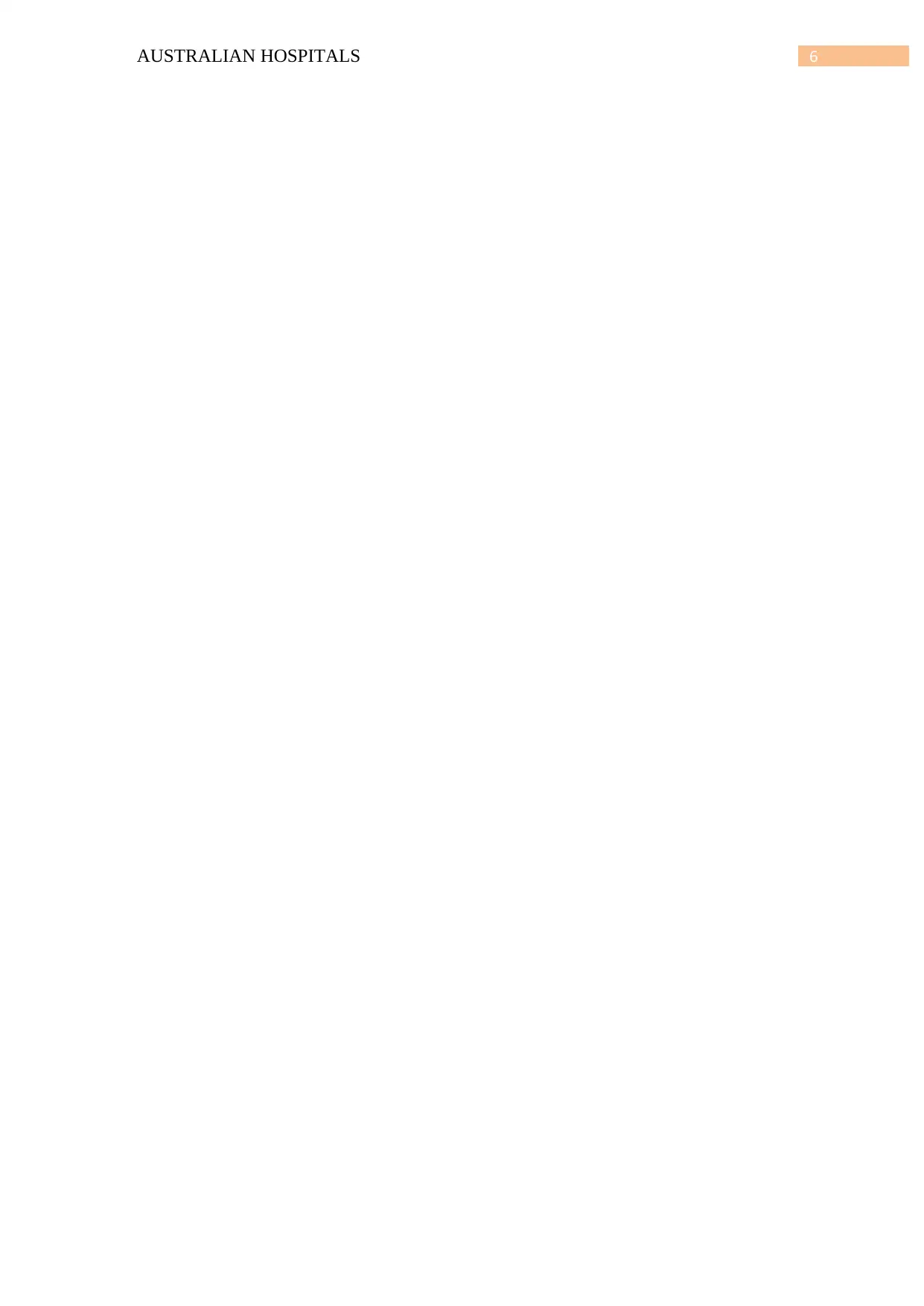
6AUSTRALIAN HOSPITALS
1 out of 7
Related Documents
Your All-in-One AI-Powered Toolkit for Academic Success.
+13062052269
info@desklib.com
Available 24*7 on WhatsApp / Email
![[object Object]](/_next/static/media/star-bottom.7253800d.svg)
Unlock your academic potential
Copyright © 2020–2025 A2Z Services. All Rights Reserved. Developed and managed by ZUCOL.





